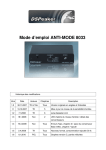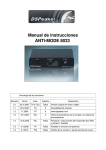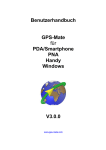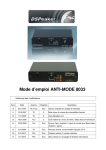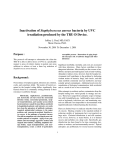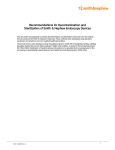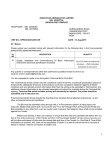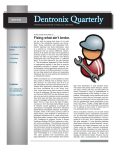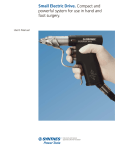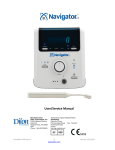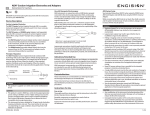Download Manual, Instrument Cleaning and Sterilization Guide
Transcript
Instrument Cleaning and Sterilization Guide Manual Instruments, Power Instruments, Accessories In accordance with ISO 17664 Linvatec Corporation 11311 Concept Blvd., Largo, FL 33773-4908 USA ©2009 Linvatec Corporation. All rights reserved. Printed in USA. • Phone: (727) 392-6464 • Customer Service: (800) 237-0169 • USA Fax: (727) 399-5256 • International Fax: (727) 397-4540 • email: [email protected] • www.linvatec.com EC Rep: ConMed Linvatec, BioMaterials, Ltd. Hermiankatu 6-8 L 33720 Tampere, FINLAND Table of Contents 1.0 2.0 Important Information 1.1 Introduction . . . . . . . . . . . . . . . . . . . . . . . . . . . . . . . . . . . . . . . . . . . . . . . . . . . . . . . . . .1 1.2 Warnings, Cautions and Notes . . . . . . . . . . . . . . . . . . . . . . . . . . . . . . . . . . . . . . . . . . .1 i 1.2.1 Warnings . . . . . . . . . . . . . . . . . . . . . . . . . . . . . . . . . . . . . . . . . . . . . . . . . . . . .1 1.2.2 Cautions . . . . . . . . . . . . . . . . . . . . . . . . . . . . . . . . . . . . . . . . . . . . . . . . . . . . . .2 Cleaning 2.1 Medical Device Cleaning Groups . . . . . . . . . . . . . . . . . . . . . . . . . . . . . . . . . . . . . . . . .3 2.2 Cleaning Options. . . . . . . . . . . . . . . . . . . . . . . . . . . . . . . . . . . . . . . . . . . . . . . . . . . . . .3 2.3 Cleaning Equipment . . . . . . . . . . . . . . . . . . . . . . . . . . . . . . . . . . . . . . . . . . . . . . . . . . .4 2.4 Cleaning Instructions . . . . . . . . . . . . . . . . . . . . . . . . . . . . . . . . . . . . . . . . . . . . . . . . . .5 2.5 3.0 Page 2.4.1 Manual Cleaning Steps (All Groups) . . . . . . . . . . . . . . . . . . . . . . . . . . . . . . . .5 2.4.2 Automated Washer / Sanitizer Steps (Group 1 ONLY). . . . . . . . . . . . . . . . . .6 2.4.3 Combined Manual / Automated Cleaning Steps (Groups 1 through 4 and Group 6) . . . . . . . . . . . . . . . . . . . . . . . . . . . . . . . . . .8 Cleaning Instructions for Instruments with Electronics and Batteries . . . . . . . . . . . . .9 2.5.1 Warnings for Instruments with Electronics and / or Batteries . . . . . . . . . . . . .9 2.5.2 Cautions for Instruments with Electronics and Batteries . . . . . . . . . . . . . . . .10 2.5.3 Battery Cleaning. . . . . . . . . . . . . . . . . . . . . . . . . . . . . . . . . . . . . . . . . . . . . . .10 Sterilization Information . . . . . . . . . . . . . . . . . . . . . . . . . . . . . . . . . . . . . . . . . . . . . .11 1.0 1.1 Important Information Introduction The purpose of this guide is to provide detailed, recommended practices for the care, cleaning, and sterilization of ConMed Linvatec manual reusable surgical instruments, as well as, pneumatic, electrical, electronic, and battery operated equipment and associated accessories. This guide is intended to assist health care personnel in the safe, proper and effective handling practices during cleaning, sterilization, and maintaining the equipment. This guide should be studied carefully. The user/processor should comply with local laws and ordinances in countries where reprocessing requirements are more stringent than those detailed in this guide. This guide is intended to be used with the Instructions For Use (IFU) and / or User Manual supplied with the devices. These instructions provide specific information for maintenance and care, as well as disassembly instructions if applicable. In addition, refer to the IFU and / or User Manual technical specifications or special cleaning / sterilization recommendations related to the product / system. This guide is to be used as a supplement to the device’s Instructions For Use (IFU) or User Manual. If in doubt with any cleaning or sterilization instructions, follow the IFU or User Manual instructions explicitly. Keep all instructions where they are easily accessible for the persons handling the product. If you have any questions or need help during a procedure, contact your ConMed Linvatec Sales Representative or Customer Service. Outside the U.S.A. contact the nearest ConMed Linvatec subsidiary or Customer Service. • Phone: (727) 392-6464 • Customer Service: (800) 237-0169 • USA Fax: (727) 399-5256 • International Fax: (727) 397-4540 • email: [email protected] • www.conmed.com 1.2 Warnings, Cautions and Notes Please read this guide and follow its instructions carefully. The words WARNING, CAUTION, and NOTE carry special meanings and should be carefully reviewed. WARNING: The personal safety of the patient, user and / or surgical staff may be involved. Disregarding this information could result in injury, death or other serious adverse reactions associated with the use or misuse of the device to the patient, user and / or surgical staff. CAUTION: These instructions alert the user to special service procedures or precautions that must be followed to avoid damaging the instrument or other property. NOTE: This provides special instructions to make maintenance instructions clearer. An exclamation point within a triangle displayed on the product is intended to alert the user to the presence of important operating and maintenance instructions in this guide. 1.2.1 Warnings • Automated cleaning using a washer/sanitizer alone may NOT be effective for complex instruments. A thorough manual cleaning process is recommended prior to any automated cleaning process. • During surgery, instruments become contaminated from blood, tissue, bone chips and marrow. The instruments may also become contaminated with body fluids containing hepatitis virus, HIV or other etiological agents and pathogens. All health care workers should become familiar with, and exercise, the necessary Universal Precautions of preventing injuries caused by sharp instruments when handling these devices during and after surgical procedures and during reprocessing. • Personal Protective Equipment should be worn when handling or working with contaminated or potentially contaminated materials, devices, and equipment, and also cleaning agents. Personal Protective Equipment includes gown, mask, goggles or face shield, gloves and shoe covers. 1 • Do not allow soiled / contaminated devices to dry prior to cleaning. All subsequent cleaning and sterilization steps are facilitated by not allowing blood, body fluid, bone and tissue debris, saline, or disinfectants to dry on devices. Immersion of manual instruments in distilled water immediately after use will facilitate cleaning and prevent proteinaceous material from drying on the instruments. Saline solutions may have corrosive effects on some metals and should not be used. Immersion or use of a washer/sanitizer on electronic devices (Group 6) will reduce the life of the handpiece. • Neutral pH enzymatic and cleaning agents are recommended and preferred for cleaning ConMed Linvatec reusable devices.1 NOTE: Reusable drill bits, reamers, rasps and other cutting devices should be carefully inspected after processing with alkaline detergents to ensure that cutting edges are fit for use. CAUTION: Single-use devices are not to be reused or sterilized. • Clean devices before first use and after every use before returning them to service. • After cleaning, sterilize as directed prior to use. • Instruments must be transported to the reprocessing area in a closed or covered container to prevent unnecessary contamination risks. Pre-soaking of manual instruments, followed by appropriate cleaning in a neutral pH protease based enzymatic solution 1 helps break down proteins and aids in cleaning complex devices, especially those with cannulations and other hard to reach areas. Always follow manufacturers instructions for the preparation and use of these solutions. 1.2.2 Cautions • Prior to use, cleaning or sterilization, remove all protective packaging and tip protector, if applicable. • All single-use devices are not to be reused or sterilized. • Use of hard water should be avoided. Softened tap water may be used for initial rinsing. Distilled water should be used for final rinsing to eliminate mineral deposits on instruments. • Metal brushes or scouring pads must not be used during manual cleaning procedures. These materials will damage the surface and finish of instruments. Soft-bristled, nylon brushes and pipe cleaners should be used. • It should be noted that saline and other irrigation fluids are often used in copious amounts during surgical procedures and will exert a corroding effect on instruments. • Whenever applicable, disassemble all manual instruments, remove attachments and accessories, and open all collets on locking mechanisms prior to treatment. Open hinged / jointed devices as recommended. Refer to the Instructions For Use or User Manual supplied with the device. • To avoid product damage (pitting, rust, degradation) DO NOT use highly aggressive agents (NaOH, NaOCl), salt solutions or other unsuitable cleaning agents. • To avoid surface discoloration or stains, dissolve powders completely if used as cleaning agents. • Rinse instruments thoroughly and carefully. If agents lacking a foam inhibitor are used, take care to remove foam during rinsing. Sterile demineralized water facilitates water spot removal from the surface. • Ensure manual instruments are completely immersed in the cleaning solution. • For proper cleaning, use preferably a protease-based cleaning agent. 1 • Use of enzymatic cleaners on plastics can cause degradation of the plastic. If enzymatic cleaners are used, thoroughly rinse with distilled or sterilized water immediately after cleaning. Failure to do so may result in degradation to the plastic. • For proper loading of the washing machine, follow the manufacturer’s recommendations. Avoid overloading to ensure that all surfaces are reached by the cleaning solution. 1. 2 Manual cleaning validations were performed using STERIS® Klenzyme® Enzymatic Presoak and Cleaner following label instructions. • Follow manufacturers recommendations for temperatures, concentrations, exposure durations and disposal restrictions. 2.0 2.1 Cleaning Table 2: Medical Device Cleaning Groups Medical Device Cleaning Groups For proper handling during cleaning, reusable ConMed Linvatec devices are classified into six groups. Some instruments may belong to more than one group. In this case, the cleaning method should be the most aggressive or combine the instructions outlined for each corresponding group. If an instrument is not included in the list below, and you are in doubt about the appropriate cleaning group, refer to the User Manual or Instructions For Use supplied with the instrument. Contact ConMed Linvatec Customer Service for clarification purposes. Group 1 Basic One-piece instruments, knot pushers, guide wires and pins, decloggers, obturators, probes 2 Basic Cutting Non-cannulated drills, bone punches, rasps, trocars 3 Cannulated and articulated components Cannulated drills and drivers, positioning guides, dilators, reusable cannulae, scope sheaths, suture hooks, Enduras, articulated forceps, graspers, scissors, punches, suture passers 4 Storage and Sterilization Cases Sterilization cases and trays If you have any questions or need help during a procedure, contact your ConMed Linvatec Sales Representative or Customer Service. Outside the U.S.A. contact the nearest ConMed Linvatec subsidiary or Customer Service. • Phone: (727) 392-6464 • Customer Service: (800) 237-0169 • USA Fax: (727) 399-5256 • International Fax: (727) 397-4540 • email: [email protected] • www.conmed.com 2.2 Optical (Systems that require non-abrasive cleaning) Cleaning Options 5 Table 1: Cleaning / Disinfection Options Method Description Manual (see page 5) Neutral pH enzyme cleaner 1 and soak and scrub. Repeat as needed. Combination Manual / Automated (see page 8) Neutral pH enzymatic 1 soak and scrub followed by washer / sanitizer 2 processing. Automated (see page 6) Representative Product Samples Description Class a Video Cameras Class b Endoscopes Powered Handpieces (Cannot be immersed) 1 Enzymatic soak followed by washer / sanitizer 2 processing (not recommended for complex devices). Electric / Electronic Handpieces Battery Handpieces 6 Pneumatic Handpieces and Hoses Cables and Batteries Powered Attachments (saw attachments, drive adaptors, bur guards, pin and wire drivers, drill and reamer attachments, Jacobs chucks) NOTE: Reference any associated IFU and / or manufacturers recommendations prior to using any machine cleaning methods. CAUTION: Immersion or use of a washer/sanitizer on Group 6 devices (electronic, electric, pneumatic, battery) will reduce the life of the handpiece. 2. All washer/sanitizer cleaning validations were performed according to AAMI guidelines using the HAMO LS-2000 Cleaning System utilizing the HAMO® preprogrammed Neutral Instrument Standard cycle and STERIS® FNE Neutral pH Detergent. 3 Table 3: Cleaning Process Matrix Table 4: Cleaning Tools Cleaning Process Cleaning Tool Manual Cleaning Only (see page 5) Manual and Automated Cleaning (see page 8) Automated Cleaning Only (see page 6) 1 • • • 2 • • 3 • • 4 • • 5 • 6 • Group •* * CAUTION: Immersion or use of a washer/sanitizer on Group 6 devices (electronic, electric, pneumatic, battery) will reduce the life of the handpiece. Note Supple (soft) polishing brush Choose appropriate diameter and length, depending on device. Hard (nylon) bristle brush Choose appropriate diameter. Carefully clean cutting areas. Flexible bottle brush Choose appropriate diameter. Scrub the inside of the equipment repeatedly. Syringe for solution injection into hard-to-reach parts. Use appropriate tip or blunt luer lock needle to flush difficult to access areas. Brush with fine, stiff bristles Choose appropriate size. Scrub flexible parts. Machine Cleaning Material: 2.3 Cleaning Equipment Manual Cleaning (and Pre-cleaning Stage Prior to Machine Cleaning) • Distilled water • Running water • Cleaning/washing agent 2 Personal Protective Equipment: • Rinsing product • Single-use shirt • Washing machine compliant with EN ISO 15883 2 • Single-use gloves • Safety glasses • Anti-splash mask (see cleaner manufacturer’s recommendations) Material: • Distilled and running water • Appropriate cleaning agent 1 • Soaking pans (preferably stainless steel) • Ultrasonic bath with adjustable temperature and stainless steel basket (Frequency: 25-50 kHz, minimum Power: 238 W), large enough for complete immersion of all manual instruments intended to be cleaned • Syringe (with appropriate tip for flushing narrow lumens) • Single-use drying paper • Thermometer • Suitable cleaning tool as shown in Table 4: 4 2.4 NOTE: If performing the OPTIONAL Ultrasonic Bath, skip step 6 listed here and go immediately to the OPTIONAL Ultrasonic Bath procedure. Cleaning Instructions 2.4.1 Manual Cleaning Steps (All Groups) Step 6 CAUTIONS: Allow device to drain. Remove excess moisture with lint-free absorbent wipe. • Whenever possible, operate articulated parts and bend flexible elements when cleaning. Using a syringe, flush solution several times into hard-to-reach areas (i.e., cannulae, holes, joints). • All single-use devices are not to be reused or sterilized. NOTES: • Clean instruments within 30 minutes of use to minimize the potential for drying prior to cleaning. • For soaking and manual cleaning, enzymatic agents 1 with both bacteriocidal and fungicidal properties are recommended. Ultrasonic Bath (OPTIONAL) CAUTION: Ultrasonic baths are not for Cleaning Groups 5 or 6. NOTE: Cleaning solutions for ultrasonic baths should be inspected prior to each use for debris and impurity. Follow manufacturer’s recommendations for replacement of solution. Step 1 Dilute cleaning agent in the ultrasonic bath as required according to manufacturers instructions. Step 2 Stir the mixture to homogenize the solution. Step 3 Prepare instrument for ultrasonic bath. Handle instruments with care. Do not let them collide. Avoid mixing instruments of different materials and conditions (operational instruments with damaged ones). Step 4 Immerse manual instruments in ultrasonic bath for cleaning. After a 15 minute immersion, brush the instrument vigorously to remove debris from the surface completely. Use proper cleaning tool. See Table 4. Step 5 Rinse thoroughly after ultrasonic bath with distilled, running water at 20° - 30°C (68-86°F) 1 • For aluminum surfaces, a neutral-pH agent should be used. To prevent corrosion, avoid contact with strong alkaline solutions (pH over 10.5) or agents containing iodine or chlorine. Reference the associated User Manual or IFU for material specifications or contact your ConMed Linvatec Sales Representative. Step 1 Step 2 Step 3 Remove excess blood, body fluids, tissue and organic soils from instruments with disposable, non-shedding wipe. Immerse manual instruments in enzyme solution 1 and allow to soak for 15 minutes. Scrub using a soft-bristled, non-abrasive brush. Use a surgical scrub or cleaning brush to remove difficult soils. Flush lumens, cannulated tubes and difficult to reach areas aggressively. Use syringe with a narrow tip to flush cleaning solution into and through all difficult to reach areas. Rinse instrument in running water for at least three minutes or until there is no evidence of blood or soil on the device or in the effluent. Use syringe to thoroughly flush lumens, cannulated tubes and difficult to reach areas. Step 4 Carefully inspect for any signs of residual soils. Repeat steps 2 and 3 until no residuals remain. Step 5 Rinse thoroughly with distilled water for at least one minute. Flush difficult to reach areas with syringe. CAUTION: Use a syringe to apply rinsing solution under pressure to hard-to-reach parts when bending or operating them as required. Step 6 Allow instruments to drain on single-use blotting paper. Remove excess moisture with lint-free absorbent wipe. Step 7 After inspection (follow inspection recommendations) repeat the pre-cleaning stage and the washing cycle if needed. Step 8 Allow device to drain. Remove excess moisture with lint-free absorbent wipe. 5 Inspection Recommendations 2.4.2 Inspect Device Prior to Sterilization NOTE: ConMed Linvatec does not define the maximum number of uses appropriate for re-usable medical devices. The useful life of these devices is dependent on many factors, including the method and duration of each use, and the handling between uses. Careful inspection and functional testing of the device before use is the best method of determining the end of serviceable life for the medical device. Generally, unmagnified visual inspection under good light conditions is sufficient. All parts of the devices should be checked for visible soil and/or corrosion. Cutting edges should be checked for sharpness and damage, or the presence of burs or jagged edges. Functional checks should be performed where possible: Mating devices should be checked for proper assembly. Medical devices with moving parts should be operated to verify correct operation. Approved lubricants, where applicable, should be applied before steam sterilization. Refer to the associated IFU or User Manual for approved lubricants and instructions for applying lubricant. Rotating devices (e.g. drill bits, reamers) should be checked for straightness. Automated Washer / Sanitizer Steps (Group 1 ONLY) CAUTIONS: • While automated washing may be effective for simple instruments requiring only surface cleaning, it is NOT RECOMMENDED for complex devices without a thorough manual precleaning following the procedures outlined below. NOTES: • Clean instruments within 30 minutes of use to minimize the potential for drying prior to cleaning. • For soaking and manual cleaning, enzymatic agents 1 with both bacteriocidal and fungicidal properties are recommended. • For machine cleaning, use only agents recommended by the machine’s manufacturer. • For aluminum surfaces, a neutral-pH agent 1 should be used. To prevent corrosion, avoid contact with strong alkaline solutions (pH over 10.5) or agents containing iodine or chlorine. Reference the associated User Manual or IFU for material specifications or contact your ConMed Linvatec Sales Representative. • Ensure the washing machine is compliant with EN ISO 15883. 2 Step 1 Remove excess blood, body fluids, tissue and organic soils from instruments with disposable, non-shedding wipe. Step 2 Immerse manual instruments in enzyme solution 1 and allow to soak for 15 minutes. Scrub using a soft-bristled, non-abrasive brush. Use a surgical scrub or cleaning brush to remove difficult soils. Flush lumens, cannulated tubes and difficult to reach areas aggressively. Use syringe with a narrow tip to flush cleaning solution into and through all difficult to reach areas. Step 3 Rinse instrument in running water for at least three minutes or until no evidence of blood or soil on the device or in the effluent. Use syringe to thoroughly flush lumens, cannulated tubes and difficult to reach areas. Remove and repair damaged instruments / containers. NOTE: If performing the OPTIONAL Ultrasonic Bath, skip step 4 listed here until AFTER the Ultrasonic Bath procedure, and go immediately to the OPTIONAL Ultrasonic Bath procedure. Step 4 6 Load in washer / sanitizer according to manufacturers instructions. Washing with a neutral pH cleaner is recommended. Ultrasonic Bath (OPTIONAL) CAUTION: Ultrasonic baths are not for Cleaning Groups 5 or 6. NOTE: Cleaning solutions for ultrasonic baths should be inspected prior to each use for debris and impurity. Follow manufacturer’s recommendations for replacement of solution. Step 1 Dilute cleaning agent in the ultrasonic bath as required according to manufacturers instructions. Step 2 Stir the mixture to homogenize the solution. Step 3 Prepare instrument for ultrasonic bath. Handle instruments with care. Do not let them collide. Avoid mixing instruments of different materials and conditions (operational instruments with damaged ones). Step 4 Step 5 Immerse manual instruments in ultrasonic bath for cleaning. After a 15 minute immersion, brush the instrument vigorously to remove debris from the surface completely. Use proper cleaning tool. See Table 4. Rinse thoroughly after ultrasonic bath with distilled, running water at 20° - 30°C (68-86°F) CAUTION: Use a syringe to apply rinsing solution under pressure to hard-to-reach parts when bending or operating them as required. Step 6 Step 7 Step 8 Allow instruments to drain on single-use blotting paper. Remove excess moisture with lint-free absorbent wipe. After inspection (follow inspection recommendations) repeat the pre-cleaning stage and the washing cycle if needed. Allow device to drain. Remove excess moisture with lint-free absorbent wipe. Inspection Recommendations Inspect Device Prior to Sterilization. NOTE: ConMed Linvatec does not define the maximum number of uses appropriate for re-usable medical devices. The useful life of these devices is dependent on many factors, including the method and duration of each use, and the handling between uses. Careful inspection and functional testing of the device before use is the best method of determining the end of serviceable life for the medical device. Generally, unmagnified visual inspection under good light conditions is sufficient. All parts of the devices should be checked for visible soil and/or corrosion. Cutting edges should be checked for sharpness and damage, or the presence of burs or jagged edges. Functional checks should be performed where possible. Mating devices should be checked for proper assembly. Medical devices with moving parts should be operated to verify correct operation. Approved lubricants, where applicable, should be applied before steam sterilization. Refer to the associated IFU or User Manual for approved lubricants and instructions for applying lubricant. Rotating devices (e.g. drill bits, reamers) should be checked for straightness. Remove and repair damaged instruments / containers. Table 5: Recommended Washer/Sanitizer Settings 2 Cycle Types: Neutral Instrument Cycle Phase Time Set Temperature Setpoint Prewash 2 minutes N/A Neutral Wash 4 minutes 60°C / 140°F Rinse 30 seconds N/A Disinfectant 5 minutes 93°C / 200°F Condensation Removal 15 seconds N/A Dry 20 minutes 110°C / 230°F Additional Dry (if needed) 15 minutes 110°C / 230°F Cool Down 2 minutes 30°C / 86°F 7 2.4.3 Combined Manual / Automated Cleaning Steps (Groups 1 through 4 and Group 6) CAUTIONS: Step 5 Load in washer / sanitizer according to manufacturers instructions. We recommend washing with a neutral pH cleaner. 1 Step 6 Allow device to drain. Remove excess moisture with lint-free absorbent wipe. • Whenever possible, operate articulated parts and bend flexible elements when cleaning. Using a syringe, flush solution several times into hard-to-reach areas (i.e., cannulae, holes, joints). • All single-use devices are not to be reused or sterilized. NOTES: • Clean instruments within 30 minutes of use to minimize the potential for drying prior to cleaning. • For soaking and manual cleaning, enzymatic agents 1 with both bacteriocidal and fungicidal properties are recommended. • For aluminum surfaces, a neutral-pH agent 1 should be used. To prevent corrosion, avoid contact with strong alkaline solutions (pH over 10.5) or agents containing iodine or chlorine. Reference the associated User Manual or IFU for material specifications or contact your ConMed Linvatec Sales Representative. Step 1 Remove excess blood, body fluids, tissue and organic soils from instruments with disposable, non-shedding wipe. Step 2 Immerse manual instruments in enzyme solution 1 and allow to soak for 15 minutes. Scrub using a soft-bristled, non-abrasive brush. Use a surgical scrub or cleaning brush to remove difficult soils. Flush lumens, cannulated tubes and difficult to reach areas aggressively. Use syringe with a narrow tip to flush cleaning solution into and through all difficult to reach areas. Step 3 Rinse instrument in running water for at least three minutes or until there is no evidence of blood or soil on the device or in the effluent. Use syringe to thoroughly flush lumens, cannulated tubes and difficult to reach areas. NOTE: If performing the OPTIONAL Ultrasonic Bath, skip steps 4 and 5 listed here until AFTER the Ultrasonic Bath procedure, and go immediately to the OPTIONAL Ultrasonic Bath procedure. Step 4 8 Carefully inspect for any signs of residual soils. Repeat steps 2 and 3 until no residuals remain. Ultrasonic Bath (OPTIONAL) CAUTION: Ultrasonic baths are not for Cleaning Groups 5 or 6. NOTE: Cleaning solutions for ultrasonic baths should be inspected prior to each use for debris and impurity. Follow manufacturer’s recommendations for replacement of solution. Step 1 Dilute cleaning agent in the ultrasonic bath as required according to manufacturers instructions. Step 2 Stir the mixture to homogenize the solution. Step 3 Prepare instrument for ultrasonic bath. Handle instruments with care. Do not let them collide. Avoid mixing instruments of different materials and conditions (operational instruments with damaged ones). Step 4 Immerse manual instruments in ultrasonic bath for cleaning. After a 15 minute immersion, brush the instrument vigorously to remove debris from the surface completely. Use proper cleaning tool. See Table 4. Step 5 Rinse thoroughly after ultrasonic bath with distilled, running water at 20° - 30°C (68-86°F) CAUTION: Use a syringe to apply rinsing solution under pressure to hard-to-reach parts when bending or operating them as required. Step 6 Allow instruments to drain on single-use blotting paper. Remove excess moisture with lint-free absorbent wipe. Step 7 After inspection (follow inspection recommendations) repeat the pre-cleaning stage and the washing cycle if needed. Step 8 Allow device to drain. Remove excess moisture with lint-free absorbent wipe. Inspection Recommendations 2.5 Inspect Device Prior to Sterilization NOTE: ConMed Linvatec does not define the maximum number of uses appropriate for re-usable medical devices. The useful life of these devices is dependent on many factors, including the method and duration of each use, and the handling between uses. Careful inspection and functional testing of the device before use is the best method of determining the end of serviceable life for the medical device. Generally, unmagnified visual inspection under good light conditions is sufficient. All parts of the devices should be checked for visible soil and/or corrosion. Cutting edges should be checked for sharpness and damage, or the presence of burs or jagged edges. Functional checks should be performed where possible. Mating devices should be checked for proper assembly. Medical devices with moving parts should be operated to verify correct operation. Approved lubricants, where applicable, should be applied before steam sterilization. Refer to the associated IFU or User Manual for approved lubricants and instructions for applying lubricant. Rotating devices (e.g. drill bits, reamers) should be checked for straightness. Remove and repair damaged instruments / containers. 2.5.1 Cleaning Instructions for Instruments with Electronics and Batteries Warnings for Instruments with Electronics and / or Batteries • Do not short circuit battery terminals or allow them to come into contact with metal objects. This could cause a shock or burn injury and also damage the battery. • Prior to use and cleaning, always inspect battery for damage (i.e., cracks in cell casing) prior to use. Do not use damaged battery. If battery is damaged and leakage or residue is noticed, do not allow it to come in contact with skin, eyes or clothing, as burns may result. If contact occurs, flush area with copious amounts of water and seek medical attention immediately. • Dispose of or recycle properly. Batteries contain nickel cadmium (NiCd) or nickel metal hydride (NiMH) and must be recycled or properly disposed. Disposal of nickel cadmium or nickel metal hydride batteries as municipal waste is prohibited. Dispose or recycle in accordance with your local, state and government regulations. In the U.S., call 1-800-925-4255 for additional information on battery disposal or recycling. Outside the U.S. contact your local ConMed Linvatec representative. 9 2.5.2 Cautions for Instruments with Electronics and Batteries • Immersion or use of a washer/sanitizer on electronic devices (Group 6) will reduce the life of the handpiece. • Do not immerse consoles, handpieces, cables or batteries in any liquid or solution. Damage to consoles will occur. Contact corrosion may occur to instruments resulting in decreased battery and / or instrument performance. • Handpieces are factory sealed. DO NOT lubricate. DO NOT disassemble any part of the handpiece. Damage will occur, thus voiding all associated warranties. 2.5.3 NOTE: Clean instruments within 30 minutes of use to minimize the potential for drying prior to cleaning. CAUTION: Use of enzymatic cleaners on plastics can cause degradation of the plastic. If enzymatic cleaners are used, thoroughly rinse with distilled or sterilized water immediately after cleaning. Failure to do so may result in degradation to the plastic. Step 1 Always detach battery from handpiece prior to cleaning. Step 2 Remove all traces of blood and coagulated material, etc. by wiping with a lint free cloth dampened with a pH-balanced detergent 1 of your choosing. Repeat cleaning if necessary until clean. Follow manufacturers instructions for the cleaning product that you select and that it is approved for use on plastics. Failure to follow these guidelines may cause damage to the battery pack. Step 3 After disinfecting the battery pack rinse and wipe it with a lint-free cloth moistened with distilled or sterile water. Rinse under running water. Step 4 Dry the battery using a lint-free cloth. Step 5 At least once a week, thoroughly clean the contact points on the battery. Use a cotton swab and a non-abrasive cleaning agent that is approved for use with metal. Do not use products such as bleach or other corrosive chemicals. Repeat cleaning if necessary until clean. Note: using tap water can cause mineral deposits to collect on the contacts which will affect operation of the handpiece. • Do not leave battery pack in the autoclave longer than the recommended sterilization exposure times. Heat and age have the greatest impact upon battery life. Strict adherence to recommended sterilization procedures is necessary. Any deviation from the recommended procedures will result in shortened battery life. • Do not expose battery to fire or incineration. • Do not clean handpieces or batteries with bleach, chlorine-based detergent, or caustic solutions that contain phenol. Chlorine or bleach will corrode metal contacts. • Use a neutral pH cleaner. 1 10 Battery Cleaning 3.0 Sterilization Information WARNING: Follow universal precautions for protective apparel when handling and cleaning contaminated instruments. CAUTIONS: • Ensure the sterilization procedure for individual devices and systems complies with accepted standard requirements. Reference the associated IFU or manual that accompanies the product for exact sterilization requirements. WARNING: Failure to follow the maintenance schedule outlined in the User Manual could result in reduced instrument performance or overheating of the handpiece or attachment. In addition, heavy use of the handpiece exceeding the recommended duty cycle can cause the handpiece to overheat. Overheating can lead to possible burn injury to the patient or medical personnel. Rotation of handpiece usage per day will assist with proper performance. Refer to the associated User Manual for all maintenance, cleaning, sterilization and handpiece duty cycle information. • Whenever applicable, disassemble manual instruments (with removable parts) open joints / hinges / locks, collets, and / or loosen connections. • If heavy loads cannot be avoided, place the instruments in different trays / cases to facilitate penetration of the agent transferring heat (steam). In addition, special care should be taken upon completion to inspect the instruments for dryness prior to storage. • Where required, sterilization exposure time and temperature may be increased above the recommendations in the device’s IFU or User Manual. As prolonged exposure time and increased temperature may affect product life, carefully inspect the device for visible damage and malfunction after treatment. • Do not leave battery packs in the autoclave longer than the recommended sterilization exposure times. Heat and age have the greatest impact on battery life. Strict adherence to recommended sterilization procedures in the IFU or User Manual is necessary. Any deviation from the recommended procedures may result in damage, thus shortening the service life. • Do not use a dry cycle on batteries, only on the Sterile Transfer Battery Case. • Additional drying time may be required on all handpieces and attachments after every sterilization process for complete heat and moisture dissipation. Operation of a handpiece that is not completely cool or dry may decrease performance and/or reliability. Reference the associated IFU or manual that accompanies the product for additional information. • Do not use handpieces or batteries while still warm after the autoclave process. Allow adequate time for cooling prior to use. Do not immerse in liquid or cover with a damp cloth to cool. Cool by exposure to room temperature. REFERENCE INFORMATION NOTE: All superscript number ones ( 1 ) and twos ( 2 ) indicated throughout this guide may be referenced here for a brief explanation. 1. Manual cleaning validations were performed using STERIS® Klenzyme® Enzymatic Presoak and Cleaner following label instructions. 2. All washer / sanitizer cleaning validations were performed according to AAMI guidelines using the HAMO LS-2000 Cleaning System utilizing the HAMO® preprogrammed Neutral Instrument Standard cycle and STERIS® FNE Neutral pH Detergent. 11 12 EC REP ConMed Linvatec BioMaterials, Ltd. Hermiankatu 6-8L 33720 Tampere, FINLAND All rights reserved. Printed in USA W41-128-004 Rev. AA 03/2009 13















